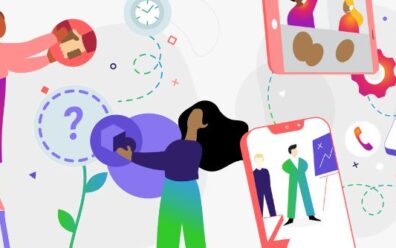Technology7-minute read
3 Technology Trends to Increase Customer Engagement
Leveraging Technology to Increase Customer Engagement
Increasing customer engagement is central to any effective sales and marketing plan. Engaged customers are more likely to expand their relationship with you to other transactions, and even bring new customers into the fold via positive word of mouth.

High levels of engagement help reduce churn and boost customer satisfaction. Among other benefits, that offsets the costly process of acquiring new customers, which can be 25 times more expensive than keeping the ones you already have. It is no less important in acquiring new customers, though; in addition to helping improve sales conversion rates, it can also deliver more qualified leads.
Engagement is clearly important, then — but how can it be achieved? This question is especially timely as commerce continues to shift to digital-based platforms, transforming the very nature of customer interaction.
From chatbots to SMS, from shopping carts to apps, from eBay to Instagram, customers are engaging with you with a huge variety of digital formats — or trying to, anyway. In such a fragmented marketplace, how can businesses focus on increased customer engagement?
Insight #1: Getting Smarter about Artificial Intelligence
Live chat has become an essential engagement tool, as it offers 24/7 availability. Whether delivered via website or app, this communications channel leverages AI to quickly and efficiently route customer inquiries. It also provides automated responses to simple, easily-answered questions, thereby freeing up live agents for more complicated issues.
Creating a system that seamlessly shifts between both AI and live agents means no lag time or inconvenience for the customer: In today’s marketplace, the customer doesn’t have to work so hard, as alternate solutions are available elsewhere. The strategic use of AI can satisfy a customer’s immediate needs more quickly, as well as usher them into a seamless experience designed to keep them engaged through conversion.
Action Item: Work to develop a system that ensures a seamless flow from AI-based to live-agent customer service, and update your workflows accordingly. Make sure you have the technology footprint in place to get the job done, whether it’s your own communications center or an outsourced contact center.
Insight #2: Making the Shift to Omnichannel Integration
One of the most startling aspects of the explosion in consumer technology in recent years is the sheer amount of it. Smartphones and tablets have given people almost limitless methods for communicating with businesses, whether it’s via mobile eCommerce, texting or social media.
It’s up to businesses to make themselves available to every channel a customer can find them on, or risk losing out an important relationship, and potentially an entire market segment. To do so effectively involves offering a truly seamless transition among all available channels – an omnichannel strategy.
The ideal omnichannel strategy involves a cross-platform integration that syncs all customer communications and touchpoints. In practice, that could be taking a social media coupon clickthrough directly to a payment page, or letting customers call a service line at any point during checkout to speak to a rep who instantly knows the details of their entire journey.
On top of ensuring a seamless brand experience, omnichannel customer service helps you better understand and invest in the channels your customers prefer, be it a robust website, an engaged social media presence, a dynamic app, and more. It can also improve efficiency by directing all inquiries to the appropriate channel or resource.
Action Item: If you’re not sure where to begin, start by making an inventory of all existing customer touchpoints. How fluid is the path between them? Can customers jump seamlessly from website chat to your customer service page, or even a common FAQ list? If you’re uncertain of any of these questions, it’s time to consult an expert.
Insight #3: Leveraging Advanced Data Intelligence & Analytics
Each interaction with a customer generates data. This includes the first moment of contact, the moment of conversion or drop-off, and all points in between — even in the documentation of the periods of time where no contact was made at all. Data intelligence and analytics, the science of tracking and using this data to improve your bottom line, isn’t new. But it has evolved in remarkable ways in recent years.
Today, the strategic use of advanced analytics can provide a suite of benefits, including:
- A clearer understanding of the exact customer journey you’re offering, helping to pinpoint bottlenecks and bounce triggers
- Insights into precisely which customers are most valuable, which are most engaged with your business and which are more at risk of churn
- A means to predict customer behavior, which helps you not only expand your relationships with existing customers but also break into new markets
- The tools to create a fully personalized customer experience and help turn casual shoppers into lifelong brand advocates.
5 Ways to Use Technology to Boost Customer Engagement
As customer expectations rise and the competition heats up, it is essential that all contact centers evolve with developing technology in order to provide a highly personalized experience. Fortunately, there are many powerful ways to use tech solutions like artificial intelligence (AI), analytics applications, cloud-based systems and more to streamline operations and serve customers better. Here are five strategies for using technology to boost your customer service capabilities without breaking the bank or compromising on quality.
- Social Media such as Facebook, Twitter, and Instagram are great tools to engage with customers. These platforms offer businesses an opportunity to interact with customers in real-time, respond to their queries, and provide support.
- Mobile Apps provide businesses with an opportunity to engage with customers on their personal devices. With a mobile app, businesses can send personalized notifications, offer loyalty programs, and provide customized offers to customers.
- Chatbots are artificial intelligence tools that can engage with customers on behalf of a business. Chatbots can provide instant responses to queries, provide product recommendations, and offer personalized assistance to customers.
- Virtual Reality (VR) and Augmented Reality (AR) technologies can be used to create immersive experiences for customers. For example, businesses can use VR to offer virtual product demos, while AR can be used to enhance in-store experiences.
- Personalize customer experiences by offering customized recommendations, tailored content, and offers based on their purchase history and preferences.
- Gamification techniques to engage customers. For example, businesses can create games or quizzes related to their products or services to encourage engagement and offer rewards to customers.
Technology offers businesses a range of opportunities to increase customer engagement. By leveraging social media, mobile apps, chatbots, VR and AR, personalization, and gamification, businesses can engage with customers in new and innovative ways, ultimately leading to increased customer loyalty and sales.
As businesses continue to adapt to the ever-changing landscape of customer engagement and marketing, embracing technology has become a crucial component of success. By leveraging the latest tools and platforms, businesses can create custom experiences that resonate with individual customers and foster strong, lasting relationships. Using the data gathered through these technological channels allows for the creation of hyper-personalized marketing strategies that speak to each customer’s unique preferences and behaviors.
The more data you have, the better you can understand what each customer likes, what they expect from you, what time of day or week they prefer to engage, and other valuable insights. All of this data is more readily available than ever before. That’s only half of the equation, though. There’s so much data that it isn’t of much use unless you have the tools to decipher, compile and interpret it.
Action Item: Whatever your method of customer communication may be, be it your own employees or an outsourced call center, double-check the use of analytics to ensure the most effective use of this important tool. If your game plan is even a year old, it’s time for an update. Don’t hesitate to contact a specialized provider if your current efforts aren’t delivering all of the benefits defined above.

Working Solutions provides data analytics services, as well as an entire suite of customer communications services.
Contact us.
This Might Interest You...
This website uses cookies to personalize and improve your experience. Continue browsing our site if you agree to our Cookie Policy or feel free to Manage Cookies yourself.
Functional Always active
Preferences
Statistics
Marketing
Subscribe to Working Solutions’ Newsletter for Timely Updates
Get the latest trends and expert advice in customer experience delivered straight to your inbox.


